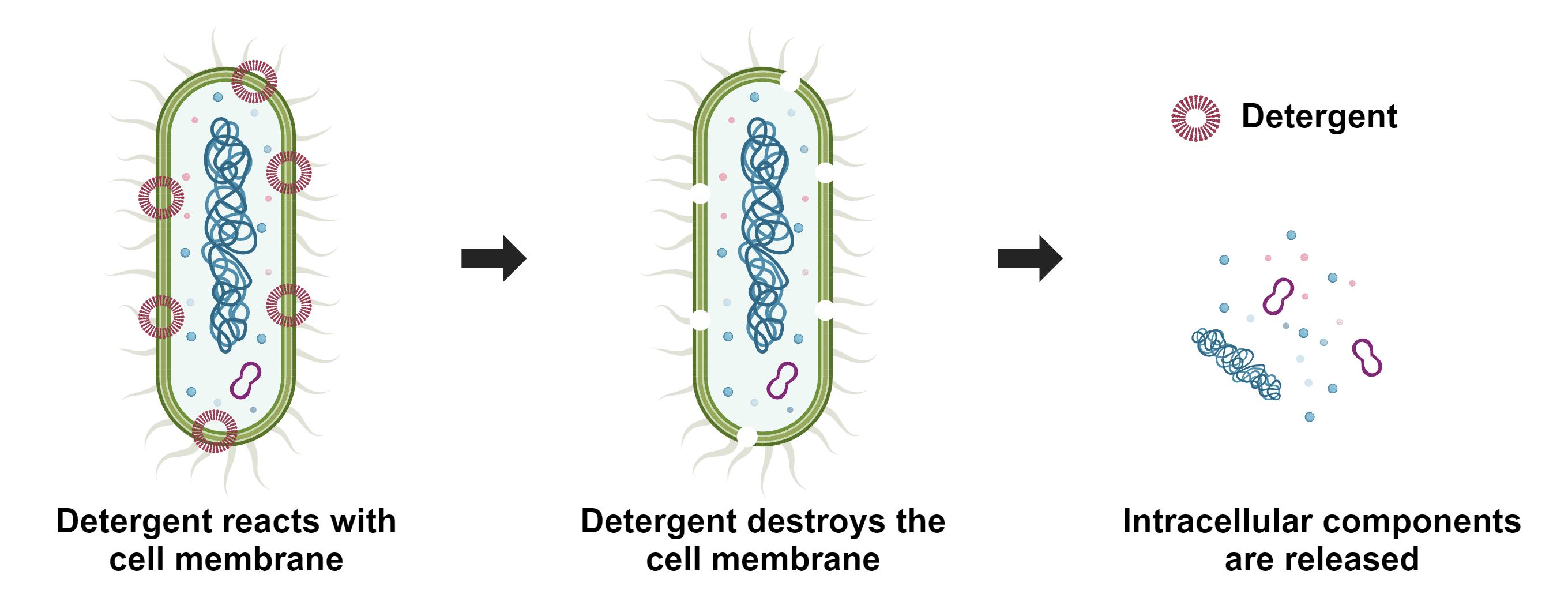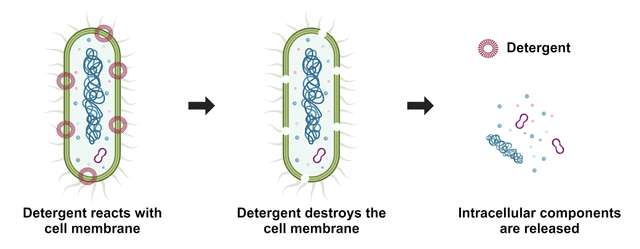ReadiUse™ bacterial cell lysis buffer *5X*
Ordering information
| Price | |
| Catalog Number | |
| Unit Size | |
| Quantity |
Additional ordering information
| Telephone | 1-800-990-8053 |
| Fax | 1-800-609-2943 |
| sales@aatbio.com | |
| International | See distributors |
| Bulk request | Inquire |
| Custom size | Inquire |
| Shipping | Standard overnight for United States, inquire for international |
Storage, safety and handling
| Intended use | Research Use Only (RUO) |
| Storage | Refrigerated (2-8 °C) |
Related products
| Overview |
Cell lysis refers to the breaking down of cells, and it is often used to analyze specific cellular compositions such as proteins, lipids, nucleic acids, reporter molecules, cell signal molecules and other small biomolecules. Depending upon the detergents used, either all or some membranes are lysed. ReadiUse™ reagents require minimal hands-on time. This bacterial cell lysis buffer just requires a simple 5-fold dilution. It is widely used for lyzing cells for quantifying small biological molecules such as NAD(P)/NAD(P)H measurement in bacteria.
Example protocol
AT A GLANCE
Important
Expiration date is 6 months from the date of receipt.
PREPARATION OF WORKING SOLUTION
ReadiUse™ bacterial cell lysis buffer working solution (1X)
Add 1 mL of ReadiUse™ bacterial cell lysis buffer (5X) into 4 mL of Mili-Q water and mix well.
SAMPLE EXPERIMENTAL PROTOCOL
Following is our recommended protocol for loading AM esters into live cells. This protocol only provides a guideline and should be modified according to your specific needs.
Prepare bacterial cell samples by collecting bacterial cells via centrifugation (10,000 g, 0°C, 15 minutes). Use about 100 to 10 million cells/mL of ReadiUse™ lysis buffer working solution (1X), and keep the treated solution at room temperature for 15 minutes.
Centrifuge at 2500 rpm for 5 minutes, and use the supernatant for further biochemical analysis.
Images

Figure 1. Bacterial cell lysis is the process of breaking down cells, which is commonly used to analyze cellular components like ribosomes, inclusion bodies, plasmids, nucleoids, and other small biomolecules. The membranes can be entirely or partially lysed, depending on the detergents used. ReadiUse™ reagents require minimal hands-on time, as this bacterial cell lysis buffer only requires a simple 5-fold dilution. It is widely used for lysing cells to quantify small biological molecules such as NAD(P)/NAD(P)H in bacteria.
Citations
View all 36 citations: Citation Explorer
Bacteriophage Therapy Increases Complement-Mediated Lysis of Bacteria and Enhances Bacterial Clearance After Acute Lung Infection With Multidrug-Resistant Pseudomonas aeruginosa
Authors: Abd El-Aziz, A. M., Elgaml, A., Ali, Y. M.
Journal: J Infect Dis (2019): 1439-1447
Authors: Abd El-Aziz, A. M., Elgaml, A., Ali, Y. M.
Journal: J Infect Dis (2019): 1439-1447
Mechanics and Dynamics of Bacterial Cell Lysis
Authors: Wong, F., Amir, A.
Journal: Biophys J (2019): 2378-2389
Authors: Wong, F., Amir, A.
Journal: Biophys J (2019): 2378-2389
Application of lysis system in bacterial vector vaccines
Authors: Tang, Y., Liu, Q., Li, P., Luo, H., Kong, Q.
Journal: Sheng Wu Gong Cheng Xue Bao (2019): 375-388
Authors: Tang, Y., Liu, Q., Li, P., Luo, H., Kong, Q.
Journal: Sheng Wu Gong Cheng Xue Bao (2019): 375-388
Quantifying bacterial cell lysis using GFP based fluorimetric assay
Authors: Sharma, M., Tyagi, J. L., Poluri, K. M.
Journal: Int J Biol Macromol (2019): 881-889
Authors: Sharma, M., Tyagi, J. L., Poluri, K. M.
Journal: Int J Biol Macromol (2019): 881-889
Viral Regulation on Bacterial Community Impacted by Lysis-Lysogeny Switch: A Microcosm Experiment in Eutrophic Coastal Waters
Authors: Chen, X., Ma, R., Yang, Y., Jiao, N., Zhang, R.
Journal: Front Microbiol (2019): 1763
Authors: Chen, X., Ma, R., Yang, Y., Jiao, N., Zhang, R.
Journal: Front Microbiol (2019): 1763
Phage single-gene lysis: Finding the weak spot in the bacterial cell wall
Authors: Chamakura, K., Young, R.
Journal: J Biol Chem (2019): 3350-3358
Authors: Chamakura, K., Young, R.
Journal: J Biol Chem (2019): 3350-3358
FRET probe-based antibacterial susceptibility testing (F-AST) by detection of bacterial nucleases released by antibiotic-induced lysis
Authors: Park, K., Jeong, J., Yi, S. Y., Lee, W. S., Shin, Y. B.
Journal: Biosens Bioelectron (2019): 225-229
Authors: Park, K., Jeong, J., Yi, S. Y., Lee, W. S., Shin, Y. B.
Journal: Biosens Bioelectron (2019): 225-229
Use of a modified bacterial ghost lysis system for the construction of an inactivated avian pathogenic Escherichia coli vaccine candidate
Authors: Hu, J., Zuo, J., Chen, Z., Fu, L., Lv, X., Hu, S., Shi, X., Jing, Y., Wang, Y., Wang, Z., Mi, R., Huang, Y., Liu, D., Qi, K., Han, X.
Journal: Vet Microbiol (2019): 48-58
Authors: Hu, J., Zuo, J., Chen, Z., Fu, L., Lv, X., Hu, S., Shi, X., Jing, Y., Wang, Y., Wang, Z., Mi, R., Huang, Y., Liu, D., Qi, K., Han, X.
Journal: Vet Microbiol (2019): 48-58
Dynamic bacterial community changes in the autothermal thermophilic aerobic digestion process with cell lysis activities, shaking and temperature increase
Authors: Cheng, H., Asakura, Y., K and a, K., Fukui, R., Kawano, Y., Okugawa, Y., Tashiro, Y., Sakai, K.
Journal: J Biosci Bioeng (2018): 196-204
Authors: Cheng, H., Asakura, Y., K and a, K., Fukui, R., Kawano, Y., Okugawa, Y., Tashiro, Y., Sakai, K.
Journal: J Biosci Bioeng (2018): 196-204
An improved in-house lysis-filtration protocol for bacterial identification from positive blood culture bottles with high identification rates by MALDI-TOF MS
Authors: Tsuchida, S., Murata, S., Miyabe, A., Satoh, M., Takiwaki, M., Matsushita, K., Nomura, F.
Journal: J Microbiol Methods (2018): 40-45
Authors: Tsuchida, S., Murata, S., Miyabe, A., Satoh, M., Takiwaki, M., Matsushita, K., Nomura, F.
Journal: J Microbiol Methods (2018): 40-45

